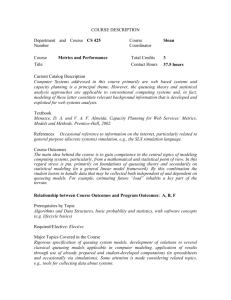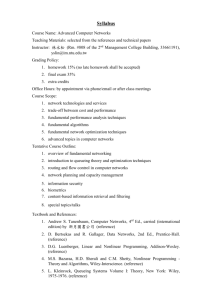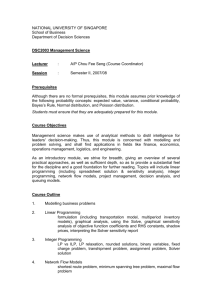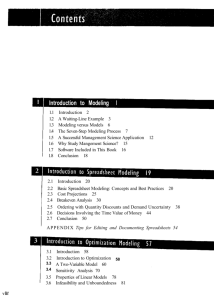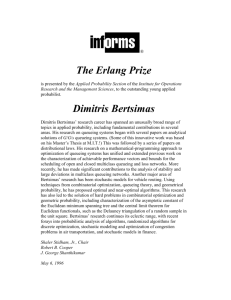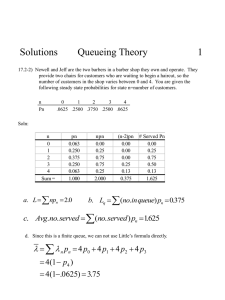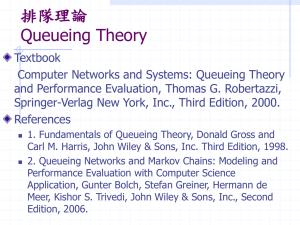QUEUEING WITH SYSTEM PASSIVE
advertisement
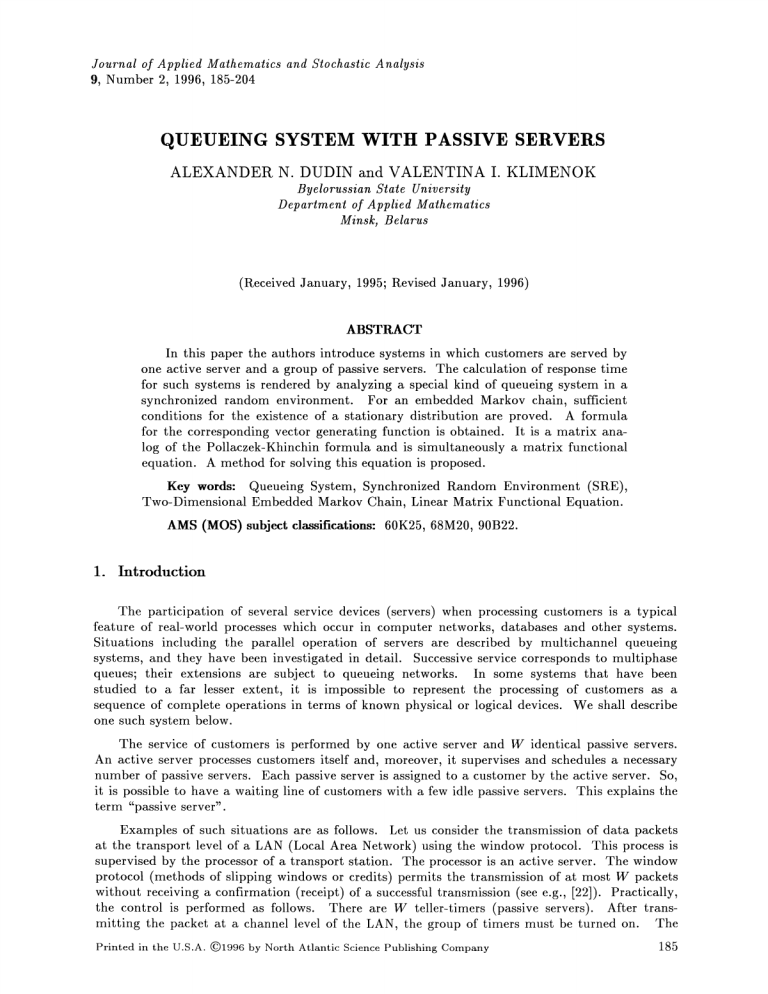
Journal of Applied Mathematics and Stochastic Analysis
9, Number 2, 1996, 185-204
QUEUEING SYSTEM WITH PASSIVE SERVERS
ALEXANDER N. DUDIN and VALENTINA I. KLIMENOK
Byelorussian State University
Department of Applied Mathematics
Minsk, Belarus
(Received January, 1995; Revised January, 1996)
ABSTRACT
In this paper the authors introduce systems in which customers are served by
one active server and a group of passive servers. The calculation of response time
for such systems is rendered by analyzing a special kind of queueing system in a
synchronized random environment. For an embedded Markov chain, sufficient
conditions for the existence of a stationary distribution are proved. A formula
for the corresponding vector generating function is obtained. It is a matrix analog of the Pollaczek-Khinchin formula and is simultaneously a matrix functional
equation. A method for solving this equation is proposed.
Key words: Queueing System, Synchronized Random Environment (SRE),
Two-Dimensional Embedded Markov Chain, Linear Matrix Functional Equation.
AMS (MOS) subject classifications: 60K25, 68M20, 90B22.
1. Introduction
The participation of several service devices (servers) when processing customers is a typical
feature of real-world processes which occur in computer networks, databases and other systems.
Situations including the parallel operation of servers are described by multichannel queueing
systems, and they have been investigated in detail. Successive service corresponds to multiphase
queues; their extensions are subject to queueing networks. In some systems that have been
studied to a far lesser extent, it is impossible to represent the processing of customers as a
sequence of complete operations in terms of known physical or logical devices. We shall describe
one such system below.
The service of customers is performed by one active server and W identical passive servers.
server processes customers itself and, moreover, it supervises and schedules a necessary
number of passive servers. Each passive server is assigned to a customer by the active server. So,
it is possible to have a waiting line of customers with a few idle passive servers. This explains the
term "passive server".
An active
Examples of such situations are as follows. Let us consider the transmission of data packets
at the transport level of a LAN (Local Area Network) using the window protocol. This process is
supervised by the processor of a transport station. The processor is an active server. The window
protocol (methods of slipping windows or credits) permits the transmission of at most W packets
without receiving a confirmation (receipt) of a successful transmission (see e.g., [22]). Practically,
the control is performed as follows. There are W teller-timers (passive servers). After transmitting the packet at a channel level of the LAN, the group of timers must be turned on. The
Printed in the U.S.A.
(C)1996 by North
Atlantic Science Publishing Company
185
ALEXANDER N. DUDIN and VALENTINA I. KLIMENOK
186
group size corresponds to the number of station-receivers of this package. If there is a lack of
turned-off timers, the active server pauses or breaks off the transmission of the packets (depending
on a realization of the transport protocol). Every timer turns off after either the confirmation is
received or the time-out of the confirmation is finished. The service of a packet by the processor
is performed in two stages. The first stage consists of reading the packet and searching turned-off
timers. The second stage consists of the generation of package transmission at a channel level.
It will be seen that the mathematical model presented in Section 2 corresponds to the above
process. An applied research project of a LAN transport station performance motivated our investigation of queueing systems with passive servers.
Another example is as follows. Consider the processing SQL-operators, which require the establishing of exclusive locks imposed on pages of a relational database table. An active server is the
database manager system (see e.g., [3]). Passive servers are the table pages on a magnetic-disk
storage device.
Consequently, queueing systems with passive servers are adequate mathematical models for
important real-world systems. However, they are neither described nor studied in the scientific
literature. That is why the present investigation of such systems is both novel and of interest.
This paper is devoted to the evaluation of customer response time in such systems. Section 2
contains a formal description of the customer service process. It turns out that in spite of a close
similarity with queueing systems, this model cannot be described in terms of any classical queueing system. However, it may be successfully described as a queueing system in a Synchronous
Random Environment (SRE). The corresponding model is formulated in Section 3. The rest of
the paper is concerned with calculation of response time.
2. Description of the Basic Service System
,.
Customers arrive at the system according to
a stationary Poisson process with rate
The
one active server and W passive servers. At first, a customer
service of customers is performed by
is served by an active server. If this server is busy upon customer’s arrival, the customer lines up.
The waiting room is of infinite capacity. Customers are picked from the queue according to the
FIFO discipline. The service of a customer by an active server consists of two phases. The
durations of the rth phase are independent, identically distributed random variables with the DF
Br(x),
cx)
the Laplace-Stieltjes transform
r(S)- f exp(-sx)dBr(x),
and finite moments
0
k- 1,2, r- 1,2.
fxkdBr(x),
0
br)=
Upon the completion of the first phase, the passive servers are engaged in service. Let be
the number of passive servers required for the service of a given customer. Here is an integervalued random variable distributed as qm
P{
m}, where qm > O,
m
O, W,
,
w
qm
1.
m--0
Some passive servers can become idle upon completion of the first phase by the active server.
At this moment, other passive servers may be processing customers arrived earlier. If the number
of free passive servers is not less than the number of servers required to process a given customer
(this number is defined as the realization of the random variable ), the passive servers begin to
process this customer. At the same time, the second phase of the service of this customer by the
active server begins. If the available passive servers are insufficient, there are two possible modes
or variants of the system’s behavior. The first one (variant #1): the active server interrupts the
service of a customer. The customer leaves the system unprocessed. Variant 2: the active
server waits until a necessary number of passive servers become free. After that, the second phase
of service by the active server begins. A passive server, switched to a busy state by the
Queueing System with Passive Servers
187
active server, remains in this state during a random time having an exponential distribution with
parameter 7- The passive server transfers into a free state without interference from an active server after this random time expires. We shall also distinguish two different ways of employing
passive servers. For variant a, the period of passive service begins upon the completion of the
second stage of service by the active server, while for variant b it begins at the start of the second
stage of service by the active server.
A combination of variants 1, 2 and a, b gives four cases 1.a, 1.b, 2.a, and 2.b.
By the sojourn time we mean the total time spent by a customer in the system (from its
arrival until departure). Throughout this paper, we will target the mean sojourn time (called also
response time) of customers. However, our results can be used for finding higher order moments
and the Laplace-Stieltjes transform of the sojourn time distribution.
The way we described the service process in a basic system seems to enable us the use of traditional queueing theory methods for investigating this process. But, unfortunately we run into considerable difficulties when trying to present the basic system in terms of any known classical
queueing system. Among other complications, it is very difficult to identify the concept of a "server", moreover to set a joint distribution of service times of successive customers. At the same
time, the processing of the basic system may be successfully described in terms of a queueing system in a SRE. By a queueing system in a random environment, we mean a queueing system
with input intensity and/or system distribution dependent upon the state of some external random process (so-called random environment). This kind of system has attracted the attention of
queueing theorists (see, for example S. Asmussen [1], A. Dudin [4, 6-8], G. Falin [9], n. Gnedenko
and I. Kovalenko [12], L. Goel [14], S. Halfin [15], M. van Hoorn and L. Seelen [16], Ya. Kogan
and V. Litvin [19], I. Korotaev [20, 21], P. Naor and V. Yechiali [33], M. Neuts [23], C. O’Cinneide and P. Purdue [24], N. Prabhu and Y. Zhu [25], P. Purdue [26], G. Regterschot and J. de
Smit [27], T. Rolski [28], J. Sztrik [31], H. Takahashi and H. Akimaru [32]). Queueing systems in
SRE are those in a random environment for which state transactions are synchronized with those
of the queue. Corresponding systems were considered in [5, 11, 18, 29, 30].
In the following section,
SRE.
we shall describe the basic system in terms of a
queueing system in
3. The Queueing Systems in SRE
We establish the following correspondence between the terms of the above basic system and
the queueing system in SRE.
Basic System
Queueing System in SItE
an active server
a server
the number of busy passive
servers at a given moment
the state of the synchronous random
environment at a given moment
Taking in account these analogs, we will interpret the basic system in terms of a queueing system in SRE as follows.
,
Customers arrive singly according to a Poisson process with rate and line up. There is unlimited waiting space. The queue discipline is first-come-first-served. The service time of each
customer consists of two phases. The durations of the rth phase are independent, identically dis-
ALEXANDER N. DUDIN and VALENTINA I. KLIMENOK
188
tributed variables with common distribution function Br(x), r 1,2. There is a random environment process t the number of busy passive servers in the basic system at the moment t with
state space {0,1,..., W}. The queueing system and the random environment interact in the followis
ing way. The random variable is activated upon completion of the first phase of service.
and
has
distriit
a
to
needed
the
servers
number of passive
associated with
process given customer,
bution qm P{ m}, m 0, W. A realization of is added to the current value of t" If the
sum exceeds W, the customer either leaves the system without the second phase of service (variant #1) or waits until the value of + t drops to W and then it immediately begins the second
phase of service (variant 2). Otherwise (if the sum does not exceed the value W) the second
phase starts immediately. The state of the random environment increases by the value of either
upon completion (variant a) or at the moment of starting (variant b) the second phase of service.
Between two consecutive moments of jumps of t, the process rlt behaves as a pure death
process with state space {0, 1,..., W} and death rate 7.
It is easily seen that this queueing system in SRE describes adequately the queueing process
in the basic system. It is also easy to see that the total sojourn time of a customer in the basic
system equals the sojourn time in the queueing system in SRE and the time between the
completion of service by an active server and the moment of freeing all passive channels servicing
the given customer. Consequently, the expected sojourn time (response time) of a customer in the
basic system is the sum of the expected sojourn time (response time) of a customer in the
queueing system in SRE and the expected value of the time till the passive servers are released.
Let
us
begin the calculation of customer’s response time in the queueing system in SRE.
We will
use the following notation:
t k is the departure moment of the kth customer from the queueing system in SRE
moment when an active server of the basic system completes the service of the kth customer);
(the
irk is the number of customers in the system at the moment t k + 0 (the length of queue in
the basic system at the moment t k -0);
is the state of random environment at the moment t k nu 0
servers in the basic system at the moment
P{itk 4c 1
the Markov chain {it, rlta}, k >_ 1;
Rv, r(z)
_
itk
r
tk + 1
zl-i + 1p{(i,v)--*(1, r)},
ponding transition probabilities, v,r- O, W;
z
<_
i, ]t
k
v}
are transition probabilities of
1 is the generating function of the corres-
w is the matrix generating function of transition probabili-
ties;
v,r(t) Crve-rTt(1 --e--/t) v-r,
cess with rate 7 from state v to state r
cx
(At) j e -At
(j,v,r,n)
of busy passive
Ck + 0);
l=i-1
n(z)
(the number
f
0
during
r
v, is the transition probability of the death proa period of time of length t,
r(t) O, if r > v;
(t)dB(t),
j
5v,
O, 0 < r < v < W,
n
1,2 is the probability
of the arrival of j customers from the Poisson stationary input flow with rate and the transition
of the death process with rate 7 from state v to state r during the time having the distribution
function Bn(t);
-At(1- z)
o
0 < r < v < W,
z < 1,
E
j=O
n
(t)dBn(t),
0
1,2 is the generating function of probabilities (j, v, r, n);
Queueing System with Passive Servers
Fv, r(t
is the distribution function of transition time of the death process with rate 7
from state v to state r, 0
o
Iv, r(s) f0 e
Fv, r(t);
189
V v,r-
_< r <_ v _< W;
v
stdF v, r( t) I-I
n--r+l nT +
f0 he-t6v, r(t)dt
s
are Laplace-Stieltjes transforms of functions
is the probability of the transition of the death process with
rate 7 from state v to state r during the interval between successive arrivals of customers from
the stationary Poisson flow with rate
.;
r(i,v) --lim
v),
P{itk i,tk
i> 0 v
is the stationary distribution of the Markov chain
r(i, v)z i,
II.v(z
z
_<
0 W
(1)
{itk’ r/tk}’ k _> 1;
1 is the generating function of the probabilities
r(i, v);
i--O
fI(z) -(IIo(z),IIl(Z),...,IIw(z))T;
T stands for vector-matrix transpose.
E is (W + 1)x (W + 1)identity matrix.
4. Stationary Distribution of Markov Chain
Let
us solve the
problem of finding the stationary distribution r(i, v),
>_ 0,
v
0, W.
First of all, we shall specify conditions for the existence of this distribution.
Theorem 1" A
sufficient
condition
of existence of limits (1)
(- 1)WD’(z)
is the validity
of the
inequality
< O,
(2)
det[R(z)- zE].
(3)
z- 1
where
D(z)
A proof is given in Appendix A.
Now we establish the main result that allows
us to find the distribution
rr(i,v),
>_ O,
v-O,W.
Theorem 2:
The vector
I(z) of generating functions IIv(z),
v-
O, W, satisfies the following
formula"
fI(z) (nT(z) z)- lnT(z)(- z V T)I](0).
(4)
Expression (4) may be called the matrix Pollaczek-Khinchin formula. It is a matrix analog
of the well-known formula for the generating function of the queue length distribution for M/G/1
system.
Proof: Stationary probabilities r(i,v) of the embedded Markov chain
determined from the system of linear algebraic equations"
W
k
> O,
are
/+1
(, v)p{(i, )-(, r)}, _> o.
(, )
v --0
{itk,]tk}
--0
()
ALEXANDER N. DUDIN and VALENTINA I. KLIMENOK
190
Multiply corresponding equations (5) by z and sum up the equations in from 0 to c.
Transform the obtained expression, taking into account that the transition probabilities P{(i, v)-(/,r)} depend on l-i and do not depend on and separately. (Note that such a property of
transition probabilities makes sense for the above notation for Rv, r(z).) While transforming, we
use the evident relation
v
v v, mP{(1, m)-(1, r)}.
rn--O
In the end,
tions
we obtain the following system of linear
algebraic equations for generating func-
IIr(z )"
II.(z)R., (z) +
zII(z)
v=0
or(O, v)
Rv, r(z)
V v, mRm, r(z)
z
r
0, W,
(6)
Lm=0
or in the matrix form
(RT(z)- zE)I(z) RT(z)(E- z V 7")1](0).
[:]
Equation (7)implies (4)in an obvious way.
lmark: For the case of our system, we have established the matrix Pollaczek-Khinchin formula for the generating function II(z). In fact, it can be shown that the same result is valid for
any two-dimensional Markov chain when one component of the chain is denumerable, the other
one is finite and transition probabilities depend only on the difference between the values of denumerable components. A proof of this more general result is going to be published separately.
To apply formula (4) we need expressions for the elements Rv, r(Z) of matrix R(z). To obtain
these expressions, we analyze the behavior of the queue and the environment during the interval
of time between successive departures. Using the formula for composite probability, we obtain
the explicit form of the transition probabilities P{(i,v)-.(1, r)}. Multiplying these probabilities
by z and summing them up, we prove the following result.
Theorem 3: Generating functions
follows:
Rv, r(z)
in the above variants 1.a, 1.b, 2.a, 2.b are
defined
as
1. Variant 1.a:
E
W
W-k
v
Rv, r (z)
E
991 (z’ v,])
qrn992 (z’] -[- m, r)
m-max{O,r-k}
k--O
+ 991(z, v, r) E
m--
qm"
(8)
qm"
(9)
W-r+l
2. Variant l.b:
min{W
v
E
Rv, r(Z)
991(z, v, ],)
E
k, r}
W
qm992(z, It, r m) 2t- 991(z, v, r)
m--max{O,r-k}
k--O
m--
E
W-r+l
3. Variant 2.a:
v
lv, r(Z)
E 991(Z’
V, ])
(10)
k=O
qm992(z, k + m, r) + 992(z, W, r)
m--max{0, r-k}
4. Variant 2.b:
m
qmf k, W m(A( 1
W+l-k
z))
Queueing System with Passive Servers
191
v
(10)
min{W
max{0,
k, r}
qm992(z, k, r m) +
r
k}
m
W
k
+
qm2(z,W- re, r-- rn)f k, W_m(A(1
z)).
O<r<v<W.
Formulas
(8)-(11)
allow us to obtain an explicit expression of the matrix
R(z)
utilized in
l(z), defined by (4), has to comply with the normalization condition:
I]T(1)I 1,
(1,..., 1)T.
(4).
The vector
where 1
(12)
For the classical M/G/1 system (the system without auxiliary passive servers), the scalar analog of formula (4) and the normalization condition (12) define completely the value of the generating function of the queue length distribution. Unfortunately, our case is more complicated. Expression (4) gives the value of the generating function l(z) for all z _< 1, except for z 0. But
this value is unknown.
vector-function II(z).
Essentially, equation
(4)
is the linear matrix functional equation in
A similar equation,
A(s)(s) C(s)( + )
(13)
investigations of queueing systems in the asynchronous Markov random environment
(see e.g., [4, 9, 12, 15]). Here (I)(s) is a vector-function. Its components are Laplace-Stieltjes trans-
occurs in
forms of the distribution functions of queue length under different current values of the environment. The matrices A(s)and C(s) are known.
A standard way of solving (13) is
as follows
(see e.g., [4, 9, 12, 15]). Let
us introduce
M(s)- A-l(s)detA(s). Form a system oflinear algebraic equations for components of vector
(I)( + cx) using the analyticity of the vector (I)(s) on the right half of the complex plane and take
one equation from every system
M(sk)C(Sk)O( + x) O,
k
(14)
0, W.
Here s o 0 is a root of the equation detA(s)= 0, sk are roots of this equation in the right
half-plane, k 1,W. The case of multiple roots can be taken into account separately. Next we
use the additional fact:
((0)
(15)
P,
where P is the stationary distribution vector of the environment. P is known a priori. Eliminate
the uncertainty of M(s)C(s)(+cx)/detA(s) at the point s- 0 and obtain an inhomogeneous
algebraic equation for components of vector (+cx), using (15). We include this equation
instead of any homogeneous equation in the above formed system. Then we solve this equation
having a nonsingular matrix. As the result, we have a known vector O(+oc). This way,
functional equation (13) is transformed into a linear matrix equation. Such an equation is solved
by using standard techniques.
We
can
apply the same idea to solve the linear matrix functional equation
(7).
That is why
ALEXANDER N. DUDIN and VALENTINA I. KLIMENOK
192
we will not discuss the solution in detail.
We shall note only
some
key points.
In spite of the fact that problems of solving (7) and (13) are similar, the problem of solving
is more complicated. An additional difficulty is connected with the lack of any additional information (except the normalization condition) concerning the value of the vector Ii(z) at any
fixed point, in particular at the point z 1. Therefore we have to make additional efforts to find
in comparison with the above plan. We will outline the additional
components of the vector
(7)
I(0)
plan briefly.
Form the homogeneous system of linear alg@raic equations for components of vector If(0) as
it was done above for the components of vector (I)(ec). In this connection we will make use of the
validity of the following assertion.
Theorem 4:
(I zl < 1} and
The determinant D(z)a z--1.
det(RT(z) zE)
has exactly W roots in the region
one simple root
The proof of this theorem is given in Appendix B.
We will perform the following preliminary elementary operations to form an inhomogeneous
equation for the components of vector II(0).
-
Sum up the equations of system (6) to obtain the following relation:
.(0,
z
n.(z)
v=O
V
z
m=O
r=O
Expanding both sides of (16) in Taylor series at z- 1 and equating corresponding coefficients,
following system of relations:
we obtain the
II(vl)(1)()(
v=0
l!
+
II
i=1
(1)( )(
r(0, v)S(vl), _> 0.
of the /th derivative of function IIv(z
)’-- is thel) value
IIv’)(1
(I)
sion for coefficients (v -V
> 0 is given in Appendix C
IIere
(17)
v=0
at z- 1. An explicit expres-
Consider system (7) at z- 1. As it follows from Theorem 4, the matrix RT(1)- E is singular. Replace one equation of system (7) by equation (17) for
0. We can show that the matrix
of the modified system is nonsingular. Inverting this matrix and multiplying by the right-hand
side of the modified system, we practically determine the relation II(1)- SII(0). Here S is the
known matrix. Using the normalization condition (12) we obtain the equation
IT(o)sT1- 1.
t
(18)
Equation (18) is a desired inhomogeneous equation. Including this equation in the above
formed system for the components of the vector II(0) we solve this system and obtain the value of
vector If(0). This way, functional equation (7) is reduced to a simple linear matrix equation. It
is easy to solve. To find the components of the vector II(z) or its derivatives at the point z- 1
we can use equation (7) or its derivatives at z- 1. To obtain a nonsingular matrix of the corresponding system we have to replace one equation of this system by the equation of system (17) for
an appropriate value of 1.
A more detailed version of the above algorithm is not included in the text of this paper and
will be published separately.
Queueing System with Passive Servers
193
5. The Calculation of Customer’s Response Time
As mentioned above, the response time of a customer in the basic system equals the total
length of two time periods. The first one, V A, is the time from customer’s arrival till his
departure from an active server (that is, a response time in the above described queueing system
in SRE). The second one, V p, is the time from the departure of a customer from an active server
until the moment when all passive servers involved in service of the given customer are released.
we consider the calculation of the value V A. Taking into account properties of the
stationary Poisson flow, it is not difficult to see that the following analog of Little’s formula is
At first
valid:
w
-1E II;(1).
VA
(19)
v--0
Using
value of
(19)
and values of
II’v(1),
0, W, derived by our algorithm, it is easy to calculate the
v
VA.
The process of releasing passive servers involved in service of the given customer is the death
process. It makes the calculation of the value V p not very difficult. The result is different for
each variant of the system’s behavior.
1. Variant 1.a:
Vp
m--1
7
r(t)dBl(t)
qm
r=0
v=0
(20)
/=1
0
2. Variant 1.b:
W
W
m=l
v=O
W
m
(x
r
v,
r--O
r(t)dBl (t)
E
i=0
0
0
5m, i(t)dB2 (t) /=1
(21)
v
where
is the probability that v passive servers are busy at the starting moment of service of an
arbitrary customer by an active server:
w
,
H.(1) r(0. v) +
m--v
r(0. m) V m. ,;
3. Variant 2.a:
Vp-
W
m
m=l
/=1
E qmE 7
-1
(22)
4. Variant 2.b:
/V
oo
2
l--l"
0
(23)
By the way, we adduce formulas for calculating the value Preject" Here Preject is the probability that a customer leaves the system without the second phase of service by the active server.
This characteristic is essential for variants 1.a and 1.b:
w
w
qm
Preject
m-1
v
v--W+l--m
v
r=W+l-m
] v,r()dBl().
0
(24)
ALEXANDER N. DUDIN and VALENTINA I. KLIMENOK
194
6. Conclusion
A mathematical model of a customer’s service by one active and a random number of passive
devices was investigated in this paper. Such a model describes adequately a wide collection of
operating technical and physical devices and processes. The problem of the response time calculation for such systems was solved by the reduction of the basic model to the queueing system in
the special kind of SRE. An approach of finding the stationary distribution was developed. This
approach was realized in an algorithm. The algorithm is coded as a C++ program for IBM-compatible personal computers. This program was used for the computation of characteristics of
several real systems and its efficiency was verified. The employment of the approach and the algorithm makes it possible to solve problems of performance evaluation, capacity planning and the
optimization of system characteristics such as: the optimal choice of the value W (receive and
send windows width, multiprogramming level and so on), the value
(the time-out of the
transmitting protocol, performance of passive servers), the throughput of a system and so on.
7-1
References
Asmussen, S., Ladder heights and the Markov-modulated M/G/1
queue, Stochastic Pro313-326.
Bellman, R., Introduction of Matrix Analysis, McGraw-Hill, New York 1960.
Date, C., A Guide to DB2, Addison-Wesley Publishing Company, Reading, MA 1984.
Dudin, A., Analysis of characteristics of data transmission process in an ISDN channel,
Automatic Control and Computer Sciences, Allerton Press, New York 6 (1987), 42-49.
Dudin, A., About queueing system M/G/1 in cyclic synchronous random environment,
XIV All-Union Workshop in Computer Networks 3 (1989), 44-48.
Dudin, A., Computation of the characteristics of an M/G/1 queueing system operating in
the memoryless semi-Markovian random environment, Technique of Telecommunications 7
(1990), 30-38.
Dudin, A. and Markov, A., Computation of the characteristics of a queueing system operating in the cyclic semi-Markovian random environment, XV All-Union Workshop in Computer Networks (1990), 241-246.
Dudin, A., The algorithm of computation of the characteristics of an M/G/1 queueing system in the semi-Markovian random environment, Fourth International Seminar in Teletraffic Theory and Computer Simulation, GPNTB, Moscow (1992), 51-55.
Falin, G., About single server queueing system with varying service rate, Eng. Cybernetics
(Izvestia of the Soviet Acad. Sci. 1 (1988), 134-137.
Gantmakher, F., The Theory of Matrices, Science, Moscow 1967.
Gelenbe, E. and Rosenberg, C., Queues with slowly varying arrival and service processes,
Management Sciences 36:8 (1990), 928-937.
Gnedenko, B. and Kovalenko, I., Introduction to Queueing Theory, Science, Moscow 1966.
Gnedenko, B., Danieljan, E., Dimitrov, B., Klimov, G., and Matveev, V., Priority Queues,
Moscow University, Moscow 1973.
Goel, L., Transient solution of a certain type of heterogeneous queues, Trabajos de Estadistica y de Investigacion Operativa 30:3 (1979), 63-70.
Halfin, S., The backlog of data in buffers with variable input and output rates, Performance of Computer-Communication Systems, Elsevier Science Publishers BV, North-Holland
(1984), 30%319.
van Hoorn, M. and Seelen, L., The SPP/G/1 queue: a single server queue with a switched
Poisson process as input process, O.R. Spektrum 5:4 (1983), 207-218.
cesses and Their Applications 37
[a]
[4]
[5]
[6]
[8]
[lO]
[12]
[13]
[14]
[15]
[16]
(1991),
Queueing System with Passive Servers
[17]
[is]
[19]
Khomichkov, I., About stationary regime existence in local area network with 1-persistent
protocol, XVII[ All-Union Workshop in Computer Networks (1992), 61-65.
Klimenok, V., Characteristics computation of queueing system M/G/1 in synchronous random environment, Analysis and Synthesis of Queueing Systems and Computer Networks,
Odessa 1 (1990), 87-92.
Kogan, Ya. and Litvin, V., Piecewise diffusion approximations for queueing problems with
heterogeneous arrivals and service, Problems of Control and Information Theory 8:5-6
(1979),
[20]
[22]
[23]
[24]
[25]
[26]
[27]
[2s]
[29]
[3o]
[31]
[32]
[33]
195
433-443.
Korotaev, I., Qneueing Systems with Varying Parameters, Tomsk University 1991.
Korotaev, I. and Spivak, R., Queueing systems operating in the semi-Markovian random
environment, Automation and Remote Control 7 (1992), 86-92.
Kuo, F., Protocols and Techniques ]’or Data Communication Networks, Prentice-Hall, New
Jersey 1981.
Neuts, M., Matrix-Geometric Solutions in Stochastic Models, Johns Hopkins University
Press, Baltimore and London 1981.
O’Cinneide, C. and Purdue, P., The M/M/c queue in a random environment, Journal of
Applied Probability 23:1 (1986), 175-184.
Prabhu, N. and Zhu, Y., Markov modulated queueing systems, Queueing Systems 5 (1989),
215-246.
Purdue, P., The M/M/1 queue in a Markovian environment, Operations Research 22:3
(1974), 562-569.
Regterschot, G. and de Smit, J., The queue M/G/1 with Markov modulated arrivals and
services, Mathematics of Operations Research 11:3 (1986), 465-483.
Rolski, T., Upper bounds of single server queues with doubly stochastic Poisson arrivals,
Mathematics of Operations Research 11:3 (1986), 442-450.
Sotelo, W., Mukumoto, K. and Fukuda, a., On multiserver queues with m-phase synchronous fluctuation of traffic intensity, Trans. of the IEICE E70:12 (1987), 1197-1194.
Sotelo, W., Mukumoto, K. and Fukuda, A., Some properties of queueing systems with fluctuating traffic intensity, Trans. of the IEICE E71 (1988), 659-668.
Sztrik, J., On the heterogeneous M/GIn blocking system in a random environment, J. of
the Operational Research Society 38:1 (1987), 57-63.
Takahashi, H. and Akimaru, H., A diffusion model for queues in randomly varying environment, Trans. of the IEICE 1 (1986), 13-20.
Yechiali, U. and Naor, P., Queueing problems with heterogeneous arrivals and service,
Oper. Res. 19 (1971), 722-734.
_
ALEXANDER N. DUDIN and VALENTINA I. KLIMENOK
196
Appendix A
Proof of Theorem 1: We will apply Moustafa’s theorem [13]. The statement below is an analog of this theorem for our case.
{itk ,vtk } k
Sufficient conditions for the Markov chain
are formulated as follows:
1, to have a stationary distribution
the chain is irreducible and aperiodic;
there are > 0, a positive integer J0, and a set of nonnegative numbers xi, v,
such that the following inequalities are valid
oo
W
i=0
r=O
>_ O,
v
E E P{(J’ v)(i, r)}xi, xj, < e, j > Jo, O, W,
E E P{(J’ v)-(i’r)}xi, < cx, j <_ Jo, O, W.
cx)
W
=0
r=O
(A.1)
v
v
(A.2)
v
r
O, W,
To ensure the irreducibility and aperiodicity of the chain, it is sufficient to write down expressions for the transition probabilities of the Markov chain.
Let
where
fir,
r
(A.3)
i>_0, r--O,W,
Xi, r--i+l+r
0, W, are some real numbers.
Demonstrate that there is a set of numbers Xi, r,
which the conditions of Moustafa’s theorem are valid.
Substituting
(A.3)
into
(A.1),
we obtain the
w
>_ 0,
r-
0, W, having the form
(A.3)
for
system of inequalities
w
1
+
r-----O
<
(A.4)
0, W.
v
r=O
Let’s verify that under condition
such that inequalities (A.4) hold.
(2)
> 0 and numbers fir,
of Theorem 1 there are
r-
0, W,
Consider the system consisting of W equations and one inequality
W
W
E R;,r(1)- 1 + r=0
E flrRv, r (1)
r=0
W
E R, (1)
r=O
fly
0,
v
W- 1,
(1.5)
W
+
1
E flrRw, r(1)
flW < 0.
(A.6)
r=O
(The idea of the transition from (A.4) to (A.5), (A.6) was derived from [17]). Let us interpret relations (A.5) as the system of linear algebraic equations for /0,/31,...,w_ 1" Rewrite
(A.5) in the form
v-1
ERv, r(1)flr + (Rv, v(1)
r=0
W
W-1
1)/v +
E
Rv, r(1)flr
r=v+l
v-0, W-1.
1
E R;,r(1)- WRv, W(1)
r=0
(A.7)
Queueing Sysrn wih Passive Servers
Taking into account the nature of
Hadamard’s
conditions:
fy
197
Rv, r(z), it is easy to see that the coefficients in (A.7) satisW-1
nv, v( 1)- 11
>
E nv, r(1)’
0, W- 1.
v
r---0
r =/= v
Therefore, the determinant d of (A.7)is not equal to zero [10]. Then (A.7) has the unique
solution
flv=, v-0, W-1,
where d v is the determinant obtained from d by replacing the vth column with the column of constant terms in (A.7).
It is easy to
see that
(A.7)
considered as the system of linear algebraic equations for
Each of them satisfies (A.8) and is the soluFind the condition under which an arbitrary solution of (A.5) will
system
riO’ ill"’" flW- 1’ W has an infinite set of solutions.
tion of the basic system
satisfy inequality (A.6).
(A.5).
Expanding determinants dr, v- 0, W- 1, in the entries of the vth column and substituting
the obtained expression for/3v, v 0, W- 1, into (A.6), we get the following inequality
RW, v (1) E Rk, w(1)Ak, v
RW, W(1)- 1 d- vE
=0
k =0
d
+
{ I rOI’ 1 d+E Rw, 1)E I rO 1 }
W,r(1)
1-
(A.9)
W-1
W-1
v(
v=0
R,r(1 Ak, v
1-
<0.
k=0
Here Ak, v is the cofactor of the entry located in the intersection of the kth row and the vth
column of determinant d..
It is easy to prove that the expression in the first braces in (A.9) is
W-1
sufficient to observe that the sum
k=0
Rk, w(1)Ak, v
D(1). To
see
this, it is
is the cofactor of the entry indexed by W
and v in the determinant D(1), v 0, W-1. Similarly, the expression in the second braces in
(A.9) is the determinant obtained from D(1) by replacing the Wth column with the column
r=0
r=0
It is easy to
r=0
see that the obtained determinant is the derivative of
D(z)
at point z
1.
Then, inequality (A.9) may be rewritten in the form
D(1) +D (1) < 0,
or, taking into account that
D(1)- 0 (see
the proof of Theorem
4),
we have
D’(1)
(A.10)
__d__ < 0
The sign of the determinant d is the same as the sign of
write d in the form
d
det
(- 1)w. To
I R(W )(1)- E (w 1)I],
prove this fact, we will
(A.11)
ALEXANDER N. DUDIN and VALENTINA I. KLIMENOK
198
where
rix.
R(w-1)(1)is the matrix IIRv, r(1) llv=o,w_land E (W-l) is the WxW identity mat0, W
r
The entries of the matrix R (W
1
-1)(1) satisfy the conditions
W-1
Rv, r(1) >_ 0 v,r-O,W-1,
ERv, r(1) < 1, v-O,W-1.
r--0
It allows us to classify the matrix as the special Minkowski-Leontjev’s matrix. For such class
of matrices it is proved in [2] that
det
(A.11)
[[ E (W 1) _/(w
1)T(1) [[ > 0.
(A.12)
may be rewritten in the form
d
(- 1)Wdet I E(W- 1) R
The last relation and inequality
minant d. Since signd- sign(- 1)
(A.12)
(W-1)T(1) II.
prove the above statement about the sign of the deter-
W, (A.10)is the equivalent to inequality (2).
Thus, under condition (2) of Theorem 1, system (A.5)-(A.6) has an infinite set of solutions.
Let
0_ (,01,...,/v)
be an arbitrary solution of system (A.5)-(A.6). This solution is a point
space, located on the line formed by the intersection of hyperplanes
(A.5). In addition, this point belongs to the (W + 1)-dimensional half-space defined by inequality
(A.6). It is not difficult to see that at a neighborhood of point rio, we can find a point fl* with coordinates/), fl,..., flv, so that for some number v > 0, the following inequMities are vMid:
of the
(W + 1)-dimensional
W
W
R’,, (1)- + r=0 Rv, r(1 fl <
1
r=0
,
v
0, W.
(A.13)
Let e- max v" In view of (A.13) for such e and fl* inequalities (A.4) hold true. Then for
O<v<W
our s and x.* -i+l+fir*, i>0, r-0 W, inequalities (A.1) are valid for any j But under the
condition of Moustafa’s theorem numbers x.* should be nonnegative Generally speaking this
condition is not satisfied in our case because arbitrarily large negative numbers in modulus may
occur among the numbers ?r*, r- 0, W. But taking into account that inequalities (A.1) should be
correct only for j > J0 we can take the required set of nonnegative numbers Xi, r,
O, r O, W,
in the form
O,
i,r
< J0
> Jo,
>max I/? I.
wherej00<r<W
In such a way, we have demonstrated that there are positive e and a set of nonnegative numbers Xi, r, >_ O, r O, W, such that for any r, 0 _< r _< W, and j > J0 inequalities (A.1) are valid.
It is easy to see that for the same Xi, r, >_ O, r O, W, and J0, inequalities (A.2) are correct also.
Appendix B
Proof of Theorem 4: First introduce some notations and prove some lemmas.
Denote
Queueing System with Passive Servers
’--
D(n)(z) det(R(n’(z)-
u’n)z),’
n
R(n)(z)
where the matrix
is derived from the matrix
(n)
is
the
E
identity
columns;
(n + 1) x (n + 1) matrix.
199
O, W,
R(z) by deleting
last W-n rows and
The correspondence between notations is as follows:
n(W)(z)- n(z), E (W)
E,
D(W)(z)- D(z).
Introduce also
det(R(vn)(z)- E(n)z), n O, W- 1,
where the matrix R(vn)(z)is derived from matrix R(n)(z) by replacing the vth column with the
T
D u( )(z)
part
(Ro, n + l(Z),Rl,n + l(z),...,Rn, n + l(z))
of the column of matrix
R(z).
Besides that, introduce the region of the plane:
s!) s
{z < 1},s!)
s
{z > 11, > 0.
a part of the curve 7s in the region
Denote by 7s the boundary of the region Se, by
e
e
a part of the curve 7s in the region Rez > 1.
Rez < 1 and by
2)
7s!1
75 (.
Let
ly.
7s!1), 7s!2
e
be parts of the curve 7s belonging to the regions Rez
e
Lemma B.I: Any function
<_ 1, Rez >
1 respective-
Rv, r(Z), v,r- O,W, complies with the inequality
Rv, r(Z) 1)-</v,r(1).
l.rs!
Proof: Using the definition of the function
validity of the inequalities:
On(Z ,v,r)
(B.1)
it is not difficult to demonstrate the
Ion(z,v,r)[Rez<l <_on(1,v,r), v,r-O,W, n=1,2.
Using
(7)-(10)
and
(B.2),
it is not difficult to prove that
Iiv,r(Z) lRez < 1 -< R,,, r(1)"
But because the curve
follows immediately from
7s(1
(B.3)
completely belongs to the region Rez _< 1, the inequality
(B.1)
(B.3)
Lemma B.2: The following inequalities hold:
w-1
I[v’v(Z)
Z
q’S(1)
>
E
i=0
IR,,i(z)
l’s(1)’
v-0, W-1,
(g.4)
ALEXANDER N. DUDIN and VALENTINA I. KLIMENOK
200
W-1
Rw, w(z)
z
l,s!)
>
i--O
IRw,(z) l ()"
Se
Rv, r(Z) we have the following
Proof: Using Lemma B.1 and properties of generating functions
sequence of relations:
W
]R.,(z)-
> 1--R.,.(1)-
(1)
Se
R. i(1),
(B.6)
v-O,W.
Recalling that, due to the nature of the system,
result of Lemma B.1, we obtain"
w
Rv, w(1)> 0
and taking into account the
w-1
R.,(1) >
i=0
i=0
iv
#v
IR.,(z) l. (1)’ v
Se
0, W- 1,
(B.7)
i=0
Inequalities
(B.4), (B.5) follow from (B.6), (B.7).
Lemma B.3: The following inequalities hold:
ID()(z)ls!l)> ID()(z)ls!l),
v-O,n, n-O,W-2.
(B.8)
Proof: For n- 0, the validity of Lemma B.3 follows, from inequality (B.4). Let now, n > 0.
Prove the correctness of (B.8) for some z 0 E 7 (1)" Consider the following system of linear alge-
s
braic equations:
(R(n)(zo) zoE(n))x (Io, + l(zo),Rl,n + l(Z0), .,Rn, + l(Z0)) T"
In view of (B.4), the entries of matrix R(n)(Zo) satisfy Hadamard’s conditions [10].
n
n
-
(B.9)
It implies
0
that this matrix is nonsingular and system (B.9) has a unique solution x
the
(Xo,X,...,xn)in
complex plane. Demonstrate that the entries of vector x satisfy the inequalities
o
I:1
< 1, i-0-.
(B.IO)
Suppose the contrary; namely, that
max
O<i<n
Consider the vth equation of system
(B.9)
rewritten in the form
n
Rv’v(Z)- Zo
Because of our assumption
x
0
iE-oRV’i(z)X-iq-Xv
Rv’n +
1
(z)xvv"
(B. 11)
0
--6
< 1, -!6 < 1,
we obtain from
(B.11)the following inequality:
Queueing System with Passive Servers
R, (z0)- z01 _<
201
R, (z0)
--0
This contradicts Hadamard’s conditions.
Thus entries of a vector satisfying
(B.9)
satisfy
(B.10)
But according to the Cramer’s
too.
rule
It implies the validity of (B.8) at any point z 0 of the curve
78(1 ).
Corollary B.I: Assertions of Lemma B.1-Lemma B.3 are valid at any point of contour C-
(Izl -1}.
Proof: The correctness of this statement for z- 0 is established by the same way as it was
[:]
done for all other points z E 7 (1)’ g---O, of contour C.
Se
Lemma B.4:
Every function Rv, v(z)-z, v-O,W has exactly one zero in the region
Proof:
The validity of
,W, imply that
v
(B.1)
for any point of contour C and inequalities
R.,.(z) c < 1, v 0, w,
R.,.()I c < Izlc.
or
The last inequality and Rouche’s theorem yields the proof of Lemma B.4.
Lemma B.5" The determinant
Proof (by induction in
2.
< 1.
D(n)(z),
n-
Yl
0, W-1, has exactly n-t-1 zeros in the region
n):
0. Proof follows from Lemma B.4.
1. n
z
Rv, v(1)< 1,
1
Let the determinant D(n-1)(z) have exactly n zeros in the region
Ve prove that D(n)(z) has exactly n + 1 zeros in the same region by showing the valid-
< n_< W-1.
ity of the inequality
In(n)(z) -(l:n,n(Z)- z) n(n- 1)(z) IC < I( o
,n
(z)-
D(n)(z)
in entries of the last row and dividing inequality
Decomposing
right-hand side we obtain the equivalent inequality:
-EI
Here
A(_n!(z]
Rn’i(z)
An’
z)
D(n(R,,,(z)
1)(Z
<
(B.12) by
its non-zero
(B.13)
1.
C
is the cofactor of the entry located at the nth row and the ith column of the
determinant’*’"’’D(n)(z).
The validity of Lemmas 2-3 at all points of contour C implies the validity
of the inequalities"
n-1
iR,,,(z)_zlc
< 1,
<1,
O,n,
n
O,W-1.
ALEXANDER N. DUDIN and VALENTINA I. KLIMENOK
202
These inequalities prove
Inequalities
(B.12)
(B.13)
and
(B.12).
and Rouche’s theorem imply that in the region
zl < 1
D(n)(z) has the same number of zeros as the function (Rn, n(Z)- z)D (n- 1)(z).
the function
But from Lemma
B.4 and the suggestion of the induction, it follows that the last function has exactly n + 1 zeros in
V!
the region [z[ < 1.
Corollary B.2: The function
w(Z -z)D (w- 1)(z) has exactly W + 1 zeros in the region
Se,
(Rw,
---0.
Proof: It is easy to see that when e0, the region S e {z: z < 1} t_J {1}. Lemma B.4 and
Lemma B.5 imply that the function under consideration has exactly W + 1 zeros in the region
]z] < 1. It is not difficult to demonstrate that the point z-1 is not a zero of this function.
Therefore, all zeros of this function in the region Se, 0, are concentrated in the region zl < 1
[:]
and there are W + 1 such zeros.
D(W)(z)
Proof of Theorem 4: The point z 1 is a root of the function
because the determinant
can be reduced to a determinant that has the zero column. Hence, the assertion of
Theorem 4 is equivalent to the assertion that the function
has exactly W + 1 zeros in the
region Se, -0 (see the reasoning about the structure of this region in the proof of the Corollary
B.2). Let us prove this modified assertion.
are formed as a result of summation
Since the functions
(Rw, w(Z)- z)D (wand multiplication of generating functions, these functions are analytic in the region S e, -0.
D(W)(1)
D(W)(z)
D(W)(z),
1)(z)
We prove that these functions satisfy the following inequality
region
Se,
on the boundary
0:
7s
[D(W)(z)-(Rw, w(Z) z)D(W-1)(z)ls
The inequality
(B.14)
of the
(B.14)
is equivalent to the inequalities
n(W)(z)
(Rw, w(z) z)D (w 1)(Z
D(W)(z)
(Rw, w(z) z)D (w 1)(z
-1
(B.15)
< 1,
<
1
1.
(B.16)
YS!2)
Decomposing the determinant D(W)(z) in the entries of the Wth row and using the results of
Lemma B.2 and Lemma B.3, which is valid for n W- 1 too, it is not difficult to verify (B.15).
We now prove (B.16). Expand the function that is minuend on the left-hand side of (B.16)
in Taylor series at point z 1. Taking into account the relation D(W)(1) 0, we obtain:
D(W)(z)
D’(W)(1)
(z- 1) + o([z- 1 1).
(Rw, w(Z)-z)D(W-1)(z) (Rw, w(1) 1)D(W 1)(1)
Using
(B.17)
and the representation
z-l+(cosqa+isin),
on the curve
7s!2
we can rewrite
<
(B.16)in the equivalent form"
(B.17)
Queueing System with Passive Servers
1-2
The validity of
(B.18)
D’(W)(1)
(Rw, w(1) 1)D (W- 1)(1)
203
ecos + o() < 1.
(B.18)
immediately follows from the below inequalities:
D’(W)(1)
D(W- 1)(1) <
(see Theorem 1),
0
Rw, w(1)- I < O, cos>0.
Thus we verified inequality
(B.14).
This latter, the result of the Corollary B.2, and Rouche’s theorem yield that the determinant
D(W)(z) has exactly W / 1 zeros in the region
Appendix C
Coefficients
(vl),
>_ O,
O, W,
v
are defined
by the formulas:
)(v0) (v0) q- (v--1), (vI) (vl), l__ 1,
where values
~"tv),
_>
1, are defined as follows:
1. Variant 1.a:
Cv
qm
m--0
r=0
k=0
0(/+1)
v,k,k + m,r
k=W-m+l
2. Variant 1.b:
qm
m--O
E
k-O
r=m
O v, k, k, r
m
-}-
k-W-m+1
3. Variant 2.a:
~()
min{v,W-m} k-i-m
W
qm
m=O
X W,r
i=0 r--O
X v,
k=WTl-m
vt(m, It) q-
t--0
r=0
k-0
1)
0 +
k,k + m,r
4. Variant 2.b:
qm
rn=O
where
[Wm
[_k=O
/+1
(/-t-1)
Ov, k,k,r- rn +
r=m
k=W-m+l
E E
i-O t-O
i’-tk)
X v, vt (rrt
W
])E X I+l-i)
,W-rn,
r-rn
1
r-rnJ
204
ALEXANDER N. DUDIN and VALENTINA I. KLIMENOK
Xfa.r
v
X
6v,(t)dB(t), v>_r,
k!
0
r
O, v<r, n-1,2,
()
1
-X
X(2)v
/bn)
(1)
r=O
r----0
{v,
r--O
1, v, kX
k -t- m, r
r,
h
>_ O,
/=0
1,
n-
O,
rx(m,k ),
Vn(mk
n
1,
(F2(m,k) q-(Fl(m,k))2)/2, n 2,
(r3(. ) + rl(. )r:(. ) + r3(. ))/.. a,
Fr(m,k)Coefficients =(1)
-V in formula
(17)
()
k
r
n
W_ m_t_ l
rt
r>l.
are defined as follows:
-=() (0)_v
W
--v=(1) 1)+m:O Vv,
m:O
w
v ,m)+ 1,
m
)-
Z Vv, m )w
m:0
